Mark VIII Tank
This WW1 British and American Army Mark VIII 'International' Tank can be found at the Tank Museum, Bovington, Dorest, BH20 6JG, England. Their website is tankmuseum.org.
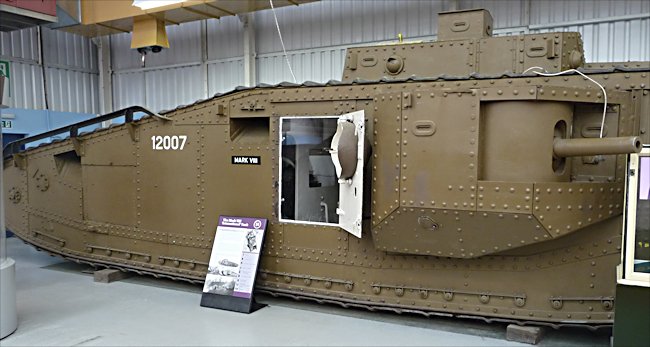
WW1 British and American Army Mark VIII 'International' Tank
A number of faults have been highlighted by British and American tank crews after the deployment on the World War I battlefield of the British Mark V tank. A committee was formed of senior officers and engineers from both armies to trying come up with a new tank design, that would overcome some of the problems of previous tank designs.
The finished tank would be called the Mark VIII. It was the first Anglo-American tank design. It was sometimes known as "the International" or as "the Liberty". The idea was that this armoured combat vehicle would equip the armies of France, Britain and America during 1918, and when there were sufficient numbers, they would be part of a mass armoured attack on German fortifications in 1919. The end of the war in 1918 stop the production of the Mark VIII tank.
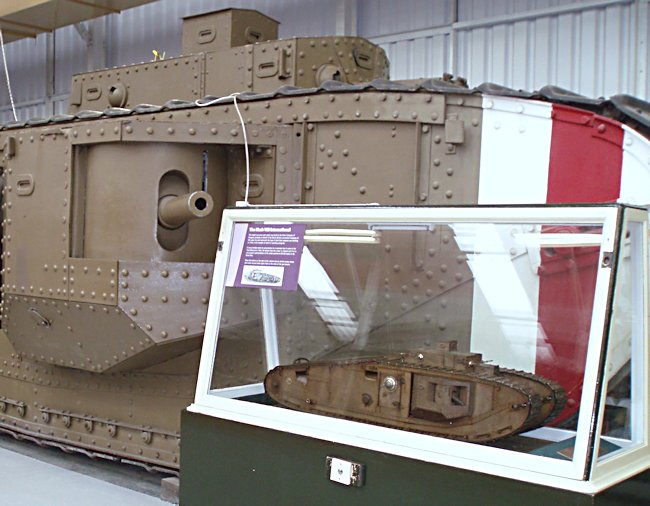
WW1 British and American Army Mark VIII 'International' Tank
Only 125 were produced before the end of the war. They were made by the North British Locomotive Company in the United Kingdom and also the Rock Island Arsenal in America. The most striking feature of this tank was its length. The Germans had been continually increasing the width of their defensive trenches to negate the trench crossing ability of the British tanks. The Mark VIII tank was 34 feet 2 inches long. The Mark V British tank was only 26 feet 5 inches long.
The Mark VIII tank was armed with two QF 6pdr (57mm) Hotchkiss guns, one on each side. Depending on availability, they were also armed with seven 7.92mm Hotchkiss machine guns or five M1917 Browning machine guns. The V-12 Liberty or Ricardo engine enabled the tank to have a maximum road speed of 5.25mph. The speed was much reduced when crossing rough battlefield muddy artillery shells scarred landscape.
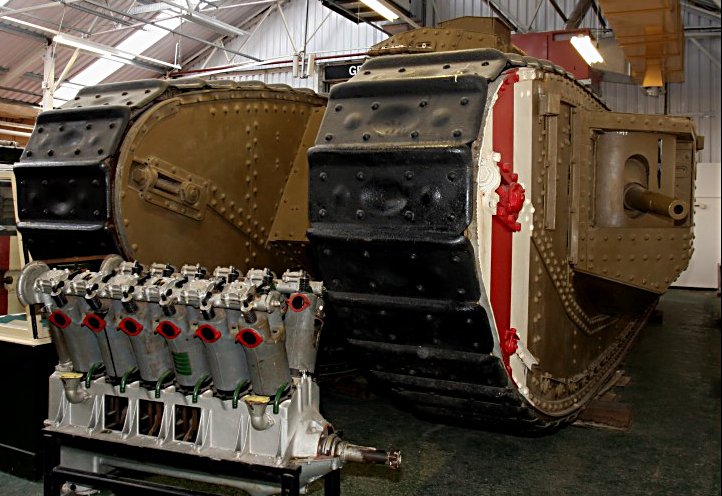
WW1 British and American Army Mark VIII 'International' Tank
One of the major new design features of this International Mark VIII tank was the compartmentalisation of the interior. A bulkhead was erected to separate the engine from the fighting compartment. This small but necessary enhancement made the conditions in the forward section of the tank much more conducive to human occupancy. No longer were the tank crew expected to fight their vehicle, whilst choking on the noxious fumes, being deafened by extremely loud noises coming from the engine and been overcome by extreme heat.
Side machine guns were mounted in to the rear of the main six pounder gun sponsons, one on each side of the tank fitted to the top of the side doors. Two additional machine guns were fitted to the front of the tank, one to the left and one to the right of the driver's position. Just above the top of the track to for machine guns were fitted, one either side behind the tank commanders position. One fault with this design was that there were no machine guns covering the rear of the tank.
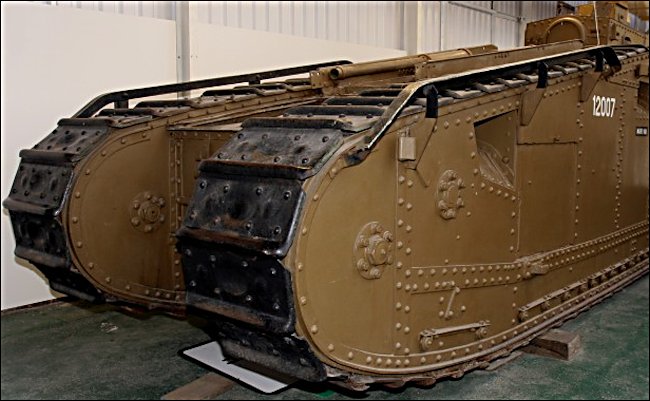
WW1 British and American Army Mark VIII International Tank
There was a lot of room to store ammunition for the guns. The 6pdr guns had enough ammunition to fire 208 shells. The Mark VIII tank could carry 13.848 machine gun rounds before it needed to be resupplied. This vehicle was a formidable weapon on the battlefield.
If the tank was immobilised on the battlefield, it instantly became a target for artillery. Many earlier tank designs burst into flames because of the lack of protection of the fuel tanks. The tank designers of the Mark VIII tank added three 200 Imperial gallon armoured fuel tanks at the rear of the vehicle. They had listened to the concerns of the tank crews who demanded better protection. The fuel gave the tank range of 80km before having to be refuelled.
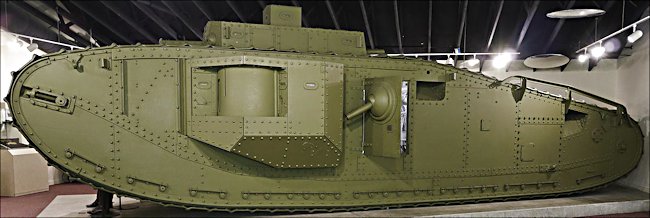
WW1 Mark VIII 'Liberty' Tank at Fort Meade, MD, USA
World War One ended before the Mark VIII tank could be properly tested battle conditions. The British army never allocated any of these tanks to operational tank unit in Europe. Out of the 125 tank Mark VIII that were made only three remain. They include the one you see the photographs on this page. This is the Mark VIII back be seen at the Bovington Tank Museum in Dorset.
Two mark VIII Liberty tanks can be found in America. One survives at Fort Meade in Maryland. The tank is displayed in the Post Museum and was made in 1920 at the Rock Island Arsenal, Illinois. It was assigned to the 301st Tank Battalion (Heavy), later designated the 17th Tank Battalion (Heavy). Throughout most of 1921–1922, Major Dwight D. Eisenhower commanded this unit. The second is at the National Armor and Cavalry Museum, Fort Benning, GA, USA
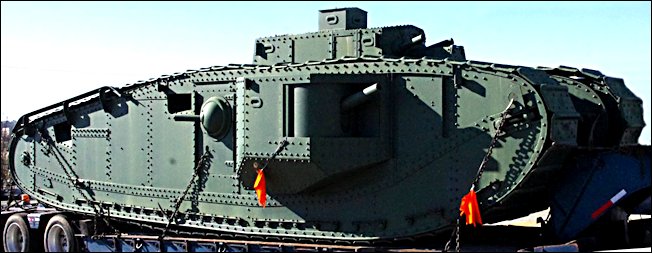
Mark VIII 'Liberty' Tank at National Armor and Cavalry Museum, Fort Benning, GA, USA going into storage. (Photo - Rob Cogan NACM)
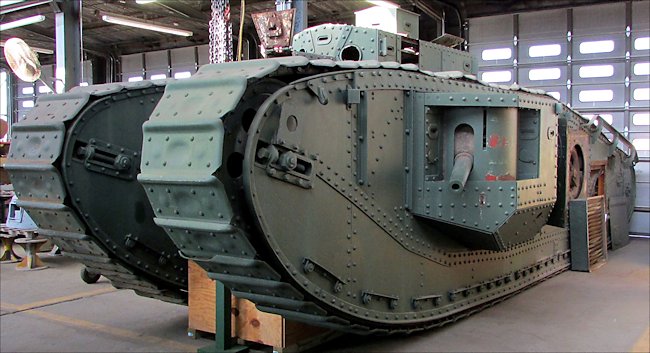
Mark VIII 'Liberty' Tank being restored at the National Armor and Cavalry Museum, Fort Benning, GA, USA. (Photo - Rob Cogan NACM) It was a joint project between US and Great Britain to mass produce a common heavy tank for planned "Grand Offensive" in 1919 before the Armistice. Crew of 10-12. Main armament of two QF 6 pdr cwt Hotchkiss Mk 2 (57mm) guns. Secondary armament of 5-7 machine guns.
Where can I find other preserved WW1 Mark VIII Tanks?
- The Tank Museum, Bovington, England
- Fort Meade, MD, USA
- National Armor and Cavalry Museum, Fort Benning, GA, USA
- Source - Pierre-Oliver Buan - http://the.shadock.free.fr/Surviving_Panzers.html
WW1 Tank books
